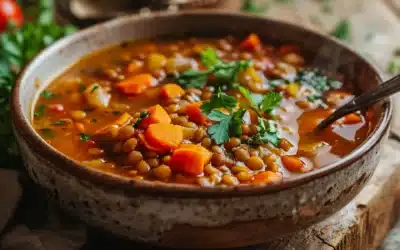Embark on a gastronomic journey that transcends borders and introduces you to the vibrant world of vegetarian cuisine. From the spiced-laden streets of India to the olive groves of the Mediterranean, vegetarian cooking offers a rich tapestry of flavors, textures, and aromas. This culinary adventure isn’t just about abstaining from meat; it’s a celebration of how cultures around the globe have harnessed the power of plants to create dishes that are both nourishing and delicious. Each region brings its unique ingredients, cooking techniques, and heritage, contributing to a diverse and exciting global vegetarian palate. In this article, we’ll explore the historical roots of vegetarian cuisine, savor the distinct flavors of Asia, the Mediterranean, and the Americas, and delve into the innovative fusion trends redefining traditional vegetarian dishes. Whether you’re a seasoned vegetarian or simply looking to expand your culinary horizons, join us on this flavorful exploration of vegetarian cuisine around the world.
Asia’s Diverse Vegetarian Delights
The Richness of Indian Vegetarian Cuisine
India, with its vast array of spices and regional culinary styles, offers a treasure trove of vegetarian dishes. From the hearty lentil-based dals of the north to the coconut-infused curries of the south, Indian vegetarian cuisine is as diverse as its culture. Staples like paneer (cottage cheese), a variety of legumes, and an array of vegetables are used to create dishes bursting with flavor.
Chinese Vegetarian Cooking: A Harmony of Flavors
Chinese cuisine offers a plethora of vegetarian options that go beyond the typical stir-fry. Ingredients like tofu, mushrooms, and bamboo shoots are used creatively in dishes that balance the five key flavors: sweet, sour, salty, bitter, and umami. Dim sum, with its delicate vegetable-filled dumplings, showcases the subtle and refined nature of Chinese vegetarian cooking.
Japanese Vegetarian Delicacies
Japanese cuisine, known for its emphasis on fresh, seasonal ingredients, presents a range of vegetarian dishes where simplicity and flavor coexist beautifully. Dishes like vegetable sushi rolls, tempura, and miso soup, often featuring tofu and seaweed, highlight the minimalist yet satisfying nature of Japanese vegetarian food.
Thai Vegetarian Flavors: A Bold Fusion
Thai cuisine is renowned for its bold flavors, combining sweet, spicy, sour, and salty. Vegetarian Thai food often includes ingredients like tofu, lemongrass, and Thai basil, creating dishes that are rich in both taste and nutrients. Curries, stir-fries, and salads with a vegetarian twist are staples of Thai cooking.
Conclusion
The diversity of Asian vegetarian cuisine is a testament to the region’s rich culinary heritage. Each country brings its unique set of flavors and ingredients, creating a rich and varied vegetarian dining experience. Whether it’s the spice-infused dishes of India, the balanced flavors of China, the fresh simplicity of Japan, or the bold combinations of Thailand, Asia offers a vegetarian culinary adventure like no other.

Mediterranean Vegetarian Fare: A Blend of Flavor and Nutrition
The Essence of Mediterranean Vegetarian Cuisine
The Mediterranean region, with its rich culinary traditions and abundance of fresh produce, offers a diverse palette of vegetarian dishes. This cuisine is celebrated for its health benefits, attributed to the use of fresh vegetables, fruits, grains, nuts, and, notably, olive oil.
Greek Vegetarian Delights
Greek cuisine offers a variety of vegetarian options that are both simple and flavorful. Dishes like Greek salads, stuffed vine leaves (dolmades), and spanakopita (spinach pie) showcase the use of fresh vegetables, olives, and feta cheese, seasoned with herbs like oregano and mint.
Italian Vegetarian Specialties
Italian cuisine is renowned for its diverse vegetarian dishes. Beyond just pasta and pizza, Italy offers a plethora of vegetable-based dishes like risottos, minestrone soup, and caponata. The use of fresh tomatoes, basil, and olive oil brings a distinct freshness to Italian vegetarian dishes.
Lebanese Vegetarian Cuisine
Lebanese cuisine is rich in vegetarian options, characterized by dishes like tabbouleh, falafel, and hummus. These dishes are not only flavorful but also packed with nutrients, featuring ingredients like lentils, chickpeas, and a variety of fresh vegetables.
Conclusion
The Mediterranean region, with its emphasis on fresh ingredients and simple cooking methods, offers a wealth of delicious and nutritious vegetarian dishes. Whether it’s the hearty salads of Greece, the pasta dishes of Italy, or the flavorful mezze of Lebanon, Mediterranean vegetarian cuisine is a testament to how flavor and health can go hand in hand.
Vegetarianism in the Americas: North to South
North American Vegetarian Flavors
In North America, vegetarian cuisine incorporates a blend of indigenous and international influences. Key ingredients include corn, beans, and a variety of vegetables. Dishes like bean burritos, vegetable stews, and corn-based salads are common, offering a fusion of flavors that reflect the continent’s diverse cultural heritage.
South American Plant-Based Delights
South American vegetarian cuisine is rich in grains like quinoa and amaranth, along with a wide variety of potatoes and legumes. Dishes such as quinoa salads, black bean burgers, and potato-based stews highlight the region’s reliance on native crops. These meals are not only hearty and flavorful but also packed with nutrients.
Central American Vegetarian Staples
Central America offers a colorful array of vegetarian options, with dishes centered around beans, corn, squash, and avocados. Traditional meals like pupusas (stuffed corn tortillas) and gallo pinto (rice and beans) showcase simple yet satisfying flavors.
Fusion and Modern Interpretations
The American continents have also embraced modern vegetarian trends, creating fusion dishes that blend traditional ingredients with new flavors and techniques. This innovation in vegetarian cuisine caters to a growing interest in plant-based diets across the Americas.
Conclusion
From the hearty bean dishes of North America to the quinoa-rich meals of South America, the American continents offer a diverse and delicious array of vegetarian options. These dishes not only reflect the rich agricultural heritage of the Americas but also cater to contemporary tastes and nutritional needs.

Fusion and Innovation: Modern Takes on Traditional Vegetarian Cuisine
The Rise of Vegetarian Fusion Cooking
The contemporary culinary world is witnessing an exciting trend: the fusion of traditional vegetarian dishes with modern, global influences. This innovative approach is not only redefining vegetarian cuisine but also expanding the horizons of what plant-based cooking can be.
Blending Cultures and Flavors
Chefs and home cooks alike are experimenting by combining elements from different culinary traditions to create unique, hybrid dishes. Imagine a Middle-Eastern inspired taco filled with falafel and tahini, or an Asian-Italian fusion dish featuring stir-fried noodles with Italian herbs. These creations are as delicious as they are inventive.
Health and Sustainability at the Forefront
Modern vegetarian fusion cuisine is not just about taste; it also reflects a growing awareness of health and sustainability. By incorporating a variety of plant-based ingredients from around the world, these dishes offer nutritional diversity and support environmentally friendly eating habits.
The Art of Vegetarian Gastronomy
This new wave of vegetarian cooking is also an artistic expression, blending colors, textures, and flavors in visually stunning and palate-pleasing ways. It’s a testament to the limitless possibilities of vegetarian cuisine when creativity takes the lead.
Conclusion
The fusion and innovation in modern vegetarian cuisine represent the ever-evolving nature of cooking. As traditional vegetarian dishes are reimagined with global influences, they offer exciting new tastes and experiences, proving that vegetarian cooking is anything but monotonous.
The Vegetarian Diet is a plant-based eating pattern that excludes meat, poultry, and seafood. This dietary choice can offer a wide range of health benefits, such as a lower risk of heart disease, improved weight management, and reduced environmental impact.
Conclusion
Our culinary journey through the world of vegetarian cuisine reveals a rich mosaic of flavors, traditions, and innovations. From the spice-infused streets of Asia to the olive-laden landscapes of the Mediterranean, and from the diverse kitchens of the Americas to the cutting-edge fusion restaurants of the modern culinary scene, vegetarian cuisine is a testament to the creativity and diversity of human culture.
This exploration underscores that vegetarian cooking is far from being restrictive; it is an expansive, ever-evolving art form that continues to push boundaries and challenge perceptions. It invites us to experience and celebrate the abundance of plant-based ingredients available globally, each contributing its unique taste and nutritional value to our plates.
As we conclude this adventure, we are left with a deeper appreciation for the intricate tapestry of vegetarian cuisine worldwide. It’s a cuisine that not only caters to the palate but also resonates with our growing consciousness towards health and sustainability. Whether you are a lifelong vegetarian or just beginning to explore this world, the journey is filled with endless possibilities and delights, waiting to be savored and cherished.












